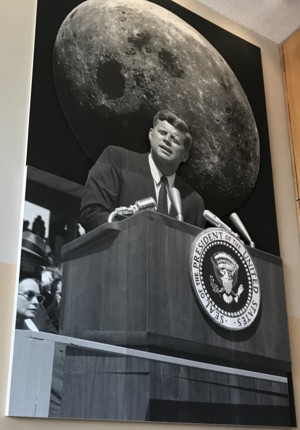At 12.56 pm on 21 July 1969 Australian Eastern Standard Time (AEST) Neil Armstrong became the first man to step down onto the Moon. I was at work that day but it was lunchtime. Workplaces did not generally run to television sets and I initially saw it in 'real time' in a shop window in the city.
Later that evening I would watch a full replay at my parents' home. They had a 'big' 26" TV - black and white of course. I had a new job in Sydney having just abandoned Canberra to get married later that year. My future in-laws, being of a more academic bent, did not have TV that was still regarded by many as mindless.
Given the early failures, and a few deaths, the decision to televise the event in 'real time' to the international public was taking a risk. But the whole space program was controversial in the US and sceptics needed to be persuaded.
In Australia we knew it was really happening because Tidbinbilla was tracking the space craft, as it had previous Apollo launches, and the Parkes radio Telescope had been requisitioned to receive the live television signal, so that an estimated 600 million viewers could watch it too. Nevertheless for a wide range of reasons, ranging from religious orthodoxy and anti-scientific scepticism to dislike of the Kennedys and big government in general, conspiracy theorists in the US and elsewhere continued to claim that it had been faked for decades later.
The Houston Apollo Control Room - now a National Monument and the Apollo 11 crew
my photos - see Houston on this website: Read more...
The immediate media reaction to Armstrong's: 'one small step for man one giant leap for mankind', statement was a bit unforgiving. In the heat of the moment, with his heart rate racing; literally stepping into the unknown; Armstrong had fumbled his lines. He should have said: 'a man'.
As it was the recording, that will now last, as of a seminal moment in history, into the unforeseeable future, is redundant and makes no sense - an added proof, if one were needed, that it wasn't pre-recorded or faked.
I've talked about Kennedy's motivation for the project elsewhere on this website [Read more...] but the outcomes for the entire world turned out to be totally unpredictable and massive. Initially engineering in the US had not been up to the task and the space program stumbled from one disaster to the next, with the Russians clearly in advance, but now some centralised discipline needed to be imposed - to herd the cats. Simply using a single standard of weights and measures was a challenge.
Yet the incredible challenges involved required new technology and an open cheque had been committed. Billions of dollars funded tens of thousands of research projects that led to many thousands of innovations. New materials and methods of manufacture were developed. Perhaps the most important were semiconductor electronics at companies like Fairchild and Bell Labs and computer science at the previously mechanical card sorting and calculating companies: NCR and IBM that had once been sceptical of this newfangled electronic stuff. Engineering and science educators expanded to provide the young researchers, engineers and programmers.
Unlike the wartime 'Manhattan Project' much of the research was published. Scientific American was required reading among my friends. In any case the speed of innovation rendered advances redundant in a matter of months. Thus quite a bit of this taxpayer funded technology 'fell off the back of the truck' and computer engineering entrepreneurs like Hewlett Packard, who had got their start making sound equipment for Walt Disney, quickly took advantage, soon to be joined by many others. So that today electronics and communications related industry has become the core of the US economy.
Today the computing and communications technology you are using to read this is several millions of times more powerful than that employed to put Neil Armstrong on the Moon and this is indeed a testament to that 'giant leap' that, in part, enabled 'one small step for (a) man' 50 years ago.

